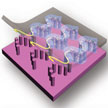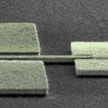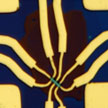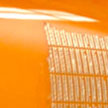Showing Spotlights 105 - 112 of 262 in category All (newest first):
 Current research on tactile sensors is mostly focused on the improvement of sensitivity and multi-functionality to emulate the function of natural skin. However, natural skin can sense external pressure and help form haptic memory, while current flexible tactile sensors for electronic skin can only perform sensing functions. This functionality gap between state-of-the-art tactile sensing devices and natural skin inspired a team of researchers to develop haptic memory devices that integrate sensor and memory functions.
Current research on tactile sensors is mostly focused on the improvement of sensitivity and multi-functionality to emulate the function of natural skin. However, natural skin can sense external pressure and help form haptic memory, while current flexible tactile sensors for electronic skin can only perform sensing functions. This functionality gap between state-of-the-art tactile sensing devices and natural skin inspired a team of researchers to develop haptic memory devices that integrate sensor and memory functions.
Dec 23rd, 2015
 One of the challenges of fabricating flexible electronics has been the trade-off between a material's high flexibility and adaptability, and its conductivity. Exploring feasible methods for guiding conducting or semiconducting nanomaterials into elastomeric matrices will be key to further progress in this area. A promising approach has just been reported by scientists, who have developed a facile printing strategy to assemble silver nanoparticles into micro- and nano-curve structures via a pillar-patterned silicon template. The curves with various tortuosity morphologies have differential resistive strain sensitivity, which can be integrated into a multi-analysis flexible sensor to perform complex-recognition of human facial expressions.
One of the challenges of fabricating flexible electronics has been the trade-off between a material's high flexibility and adaptability, and its conductivity. Exploring feasible methods for guiding conducting or semiconducting nanomaterials into elastomeric matrices will be key to further progress in this area. A promising approach has just been reported by scientists, who have developed a facile printing strategy to assemble silver nanoparticles into micro- and nano-curve structures via a pillar-patterned silicon template. The curves with various tortuosity morphologies have differential resistive strain sensitivity, which can be integrated into a multi-analysis flexible sensor to perform complex-recognition of human facial expressions.
Dec 15th, 2015
 Researchers have successfully used amorphous metal tungsten nitride to demonstrate nanoelectromechanical switches that are capable of sub-1 volt operation. In the past, attaining sub-1 volt operation at dynamic state and faster switching was extremely difficult. These efforts required the use of very expensive lithography systems to pattern nanoscale free-hanging switches. This is the first ever demonstration of a 3-terminal NEM switch.
Researchers have successfully used amorphous metal tungsten nitride to demonstrate nanoelectromechanical switches that are capable of sub-1 volt operation. In the past, attaining sub-1 volt operation at dynamic state and faster switching was extremely difficult. These efforts required the use of very expensive lithography systems to pattern nanoscale free-hanging switches. This is the first ever demonstration of a 3-terminal NEM switch.
Dec 8th, 2015
 Rollable displays and other flexible, stretchable electronic systems are often enabled by the successful integration of nanostructured materials. Most commercially available flexible electronic circuits and devices are fabricated on flexible plastic substrates, such as polymeric amides, PEEK polymers, or transparent conductive polyester films. Although these substrates can be easily bent and rolled up, they cannot be used to fabricate rollable display-integrated gadgets that are fixed at a rigid perpendicular position on their own. To overcome this issue, researchers have now used a reversibly bistable material to demonstrate flexible electronics.
Rollable displays and other flexible, stretchable electronic systems are often enabled by the successful integration of nanostructured materials. Most commercially available flexible electronic circuits and devices are fabricated on flexible plastic substrates, such as polymeric amides, PEEK polymers, or transparent conductive polyester films. Although these substrates can be easily bent and rolled up, they cannot be used to fabricate rollable display-integrated gadgets that are fixed at a rigid perpendicular position on their own. To overcome this issue, researchers have now used a reversibly bistable material to demonstrate flexible electronics.
Oct 26th, 2015
 The age of wearable electronics is upon us as witnessed by the fast growing array of smart watches, fitness bands and other advanced, next-generation health monitoring devices such as electronic stick-on tattoos. In order for these wearable sensor devices to become fully integrated into sophisticated monitoring systems, they require wireless interfaces to external communication devices such as smartphones. This requires far-field communication systems that, like the sensor systems, perform even under extreme deformations and during extended periods of normal daily activities.
The age of wearable electronics is upon us as witnessed by the fast growing array of smart watches, fitness bands and other advanced, next-generation health monitoring devices such as electronic stick-on tattoos. In order for these wearable sensor devices to become fully integrated into sophisticated monitoring systems, they require wireless interfaces to external communication devices such as smartphones. This requires far-field communication systems that, like the sensor systems, perform even under extreme deformations and during extended periods of normal daily activities.
Oct 9th, 2015
 The noise level in devices with graphene and other two-dimensional (2D) materials has to be reduced in order to enable their practical applications. It will not be possible to build graphene-based communication systems or detectors until the noise spectral density is decreased to the level comparable with the conventional state-of-the-art transistors.Researchers have now demonstrated that the electronic noise in graphene devices can be strongly suppressed if a graphene channel is encased between two layers of hexagonal boron nitride.
The noise level in devices with graphene and other two-dimensional (2D) materials has to be reduced in order to enable their practical applications. It will not be possible to build graphene-based communication systems or detectors until the noise spectral density is decreased to the level comparable with the conventional state-of-the-art transistors.Researchers have now demonstrated that the electronic noise in graphene devices can be strongly suppressed if a graphene channel is encased between two layers of hexagonal boron nitride.
Jul 27th, 2015
 An international research team has designed and demonstrated novel self-powered human-interactive transparent nanopaper systems, utilizing transparent nanopaper as base material. This nanopaper system is based on an electrostatic induction mechanism and a dielectric material. That makes them self-powered, i.e. able to operate without the need for external power. The basic working mechanisms of the resulting devices are electrostatic induction effects caused by the retaining charges.
An international research team has designed and demonstrated novel self-powered human-interactive transparent nanopaper systems, utilizing transparent nanopaper as base material. This nanopaper system is based on an electrostatic induction mechanism and a dielectric material. That makes them self-powered, i.e. able to operate without the need for external power. The basic working mechanisms of the resulting devices are electrostatic induction effects caused by the retaining charges.
Jul 13th, 2015
 Researchers have developed a simple double-transfer printing technique that allows them to integrate high performing electronic devices - featuring state-of-the-art, non-planar, sub-20nm FinFET devices - fabricated on novel flexible thin silicon sheets with several kinds of materials exhibiting complex, asymmetric surfaces including textile, paper, wood, stone, and vinyl. This process utilizes soft materials to integrate nonplanar FinFET and planar traditional MOSFET devices onto various wavy, curvilinear, irregular, or asymmetric surfaces.
Researchers have developed a simple double-transfer printing technique that allows them to integrate high performing electronic devices - featuring state-of-the-art, non-planar, sub-20nm FinFET devices - fabricated on novel flexible thin silicon sheets with several kinds of materials exhibiting complex, asymmetric surfaces including textile, paper, wood, stone, and vinyl. This process utilizes soft materials to integrate nonplanar FinFET and planar traditional MOSFET devices onto various wavy, curvilinear, irregular, or asymmetric surfaces.
Jul 9th, 2015
 Current research on tactile sensors is mostly focused on the improvement of sensitivity and multi-functionality to emulate the function of natural skin. However, natural skin can sense external pressure and help form haptic memory, while current flexible tactile sensors for electronic skin can only perform sensing functions. This functionality gap between state-of-the-art tactile sensing devices and natural skin inspired a team of researchers to develop haptic memory devices that integrate sensor and memory functions.
Current research on tactile sensors is mostly focused on the improvement of sensitivity and multi-functionality to emulate the function of natural skin. However, natural skin can sense external pressure and help form haptic memory, while current flexible tactile sensors for electronic skin can only perform sensing functions. This functionality gap between state-of-the-art tactile sensing devices and natural skin inspired a team of researchers to develop haptic memory devices that integrate sensor and memory functions.
 Subscribe to our Nanotechnology Spotlight feed
Subscribe to our Nanotechnology Spotlight feed





